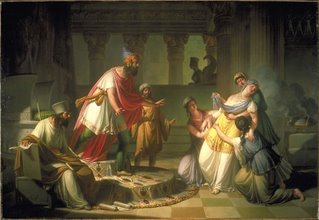Book of Esther Overview
Time: c 460 BC
Summary
Esther tells the story of the plot of Haman, the prime minister to the Persian king, to exterminate the Jewish race. This plot is foiled by Esther, the queen of Persia, who is a Jew. This book gives us the origin of the Feast of Purim.AuthorThe writer did not identify himself in the text. References in the book show that he was familiar with Persian culture and literature (Est 2:23; 10:2). The writer also wrote as though he was an eyewitness of the events he recorded. He was pro-Jewish and was probably a Jew. It is possible, though not certain, that Mordecai himself wrote the book.
Chronology
The events of the Book of Esther took place during the Persian period of ancient history (539-331 BC) and during the reign of King Ahasuerus in particular (486-464 BC).
483: Ahasuerus' military planning session in Susa
482: The deposition of Vashti
481: The beginning of Ahasuerus' unsuccessful expedition against Greece
480: Esther's arrival in Susa479: Ahasuerus' return to Susa; Esther's coronation
474: The issuing of Ahasuerus' decrees affecting the Jews
473: The Jews' defense of themselves; the establishment of the Feast of PurimThe first historical event to which the writer alluded seems to be Ahasuerus' military planning session at which he plotted the strategy for his ill-fated campaign against Greece (Est 1:3-21). The king held this planning session in the winter of 483-482 BC. The last recorded event in Esther is the institution of the Feast of Purim that took place in 473 BC. Therefore the events recorded in the book spanned a period of about 10 years.
By the time the Book of Esther opens, many Jews had returned from the Exile to Palestine to reestablish the institutions of Judaism (Ezra 1 -- 6). Most of the Jews in exile did not return even though their law (Deu 28) and the prophets (Isa 48:20; Jer 50:8; 51:6) encouraged them to do so. They preferred the comfort and convenience of life as they had come to know it outside the Promised Land -- rather than the discomfort and privation involved in obeying God. Esther and Mordecai were among those who chose not to return. [In 1893 the Babylonian expedition of the University of Pennsylvania discovered some extra-biblical documents that show how wealthy and influential some of the Jews who remained in Babylon were. See Siegfried H. Horn, "Mordecai, A Historical Problem," Biblical Research 9 (1964):22-25.]
The events of Esther fit chronologically between Ezra 6 and Ezra 7
538-515: Ezra 1-6.
520: Haggai, Zechariah.
482-473: Esther.
458: Ezra 7-10.445-420: Nehemiah.
432,431: Malachi.
Key verse: "If you remain silent at this time, relief and deliverance for the Jews will arise from another place, but you and your father's family will perish. And who knows but that you have come to royal position for such a time as this?" (Est 4:14).
Outline
1. Vashti divorced: Est 1:1–22
2. Esther made queen: Est 2:1–18
3. Mordecai uncovers a conspiracy: Est 2:19–23
4. Haman's plot against the Jews: Est 3:1–15
5. Mordecai persuades Esther to help: Est 4:1–17
6. Esther's first banquet: Est 5:1–8
7. Haman's rage against Mordecai: Est 5:9–14
8. Haman humiliated before Mordecai: Est 6:1–14
9. Esther's second banquet, Haman hanged: Est 7:1–10
10. Mordecai's counter-decree: Est 8:1–17
11. The Jews victorious and the institution of Purim: Est 9:1–32
12. Mordecai promoted: Est 10:1–3



0 Comments:
Post a Comment
<< Home